Human Resources & Employment Law Policy Analysis Report - Semester 2
VerifiedAdded on 2022/08/29
|6
|1478
|16
Report
AI Summary
This report provides a detailed analysis of various human resource and employment law policies, focusing on their compliance with the Fair Labor Standards Act of 1938 and other relevant regulations. The report evaluates proposed policies from several companies (ABC, XYZ Apparel, GRAS Lawn Maintenance, Spill, and GIP) to determine their legality and effectiveness. Key areas of focus include overtime pay, minimum wage, workplace safety, and anti-discrimination practices. The analysis highlights potential legal and practical problems associated with each policy, offering insights into how organizations can create policies that benefit both employees and the company while adhering to legal requirements. The report emphasizes the importance of proper documentation, employee training, and adherence to both federal and state laws to ensure a fair and safe work environment.
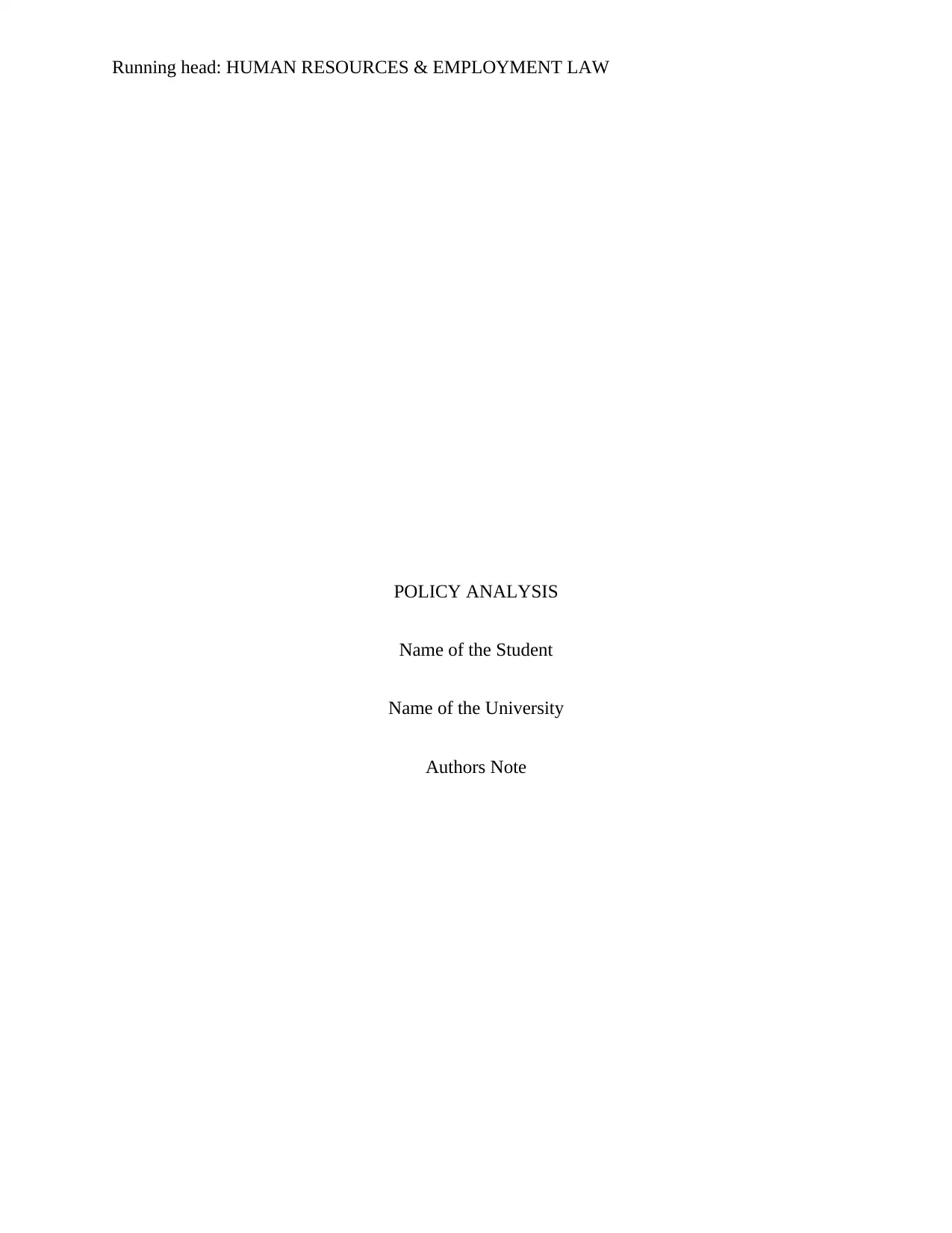
Running head: HUMAN RESOURCES & EMPLOYMENT LAW
POLICY ANALYSIS
Name of the Student
Name of the University
Authors Note
POLICY ANALYSIS
Name of the Student
Name of the University
Authors Note
Paraphrase This Document
Need a fresh take? Get an instant paraphrase of this document with our AI Paraphraser
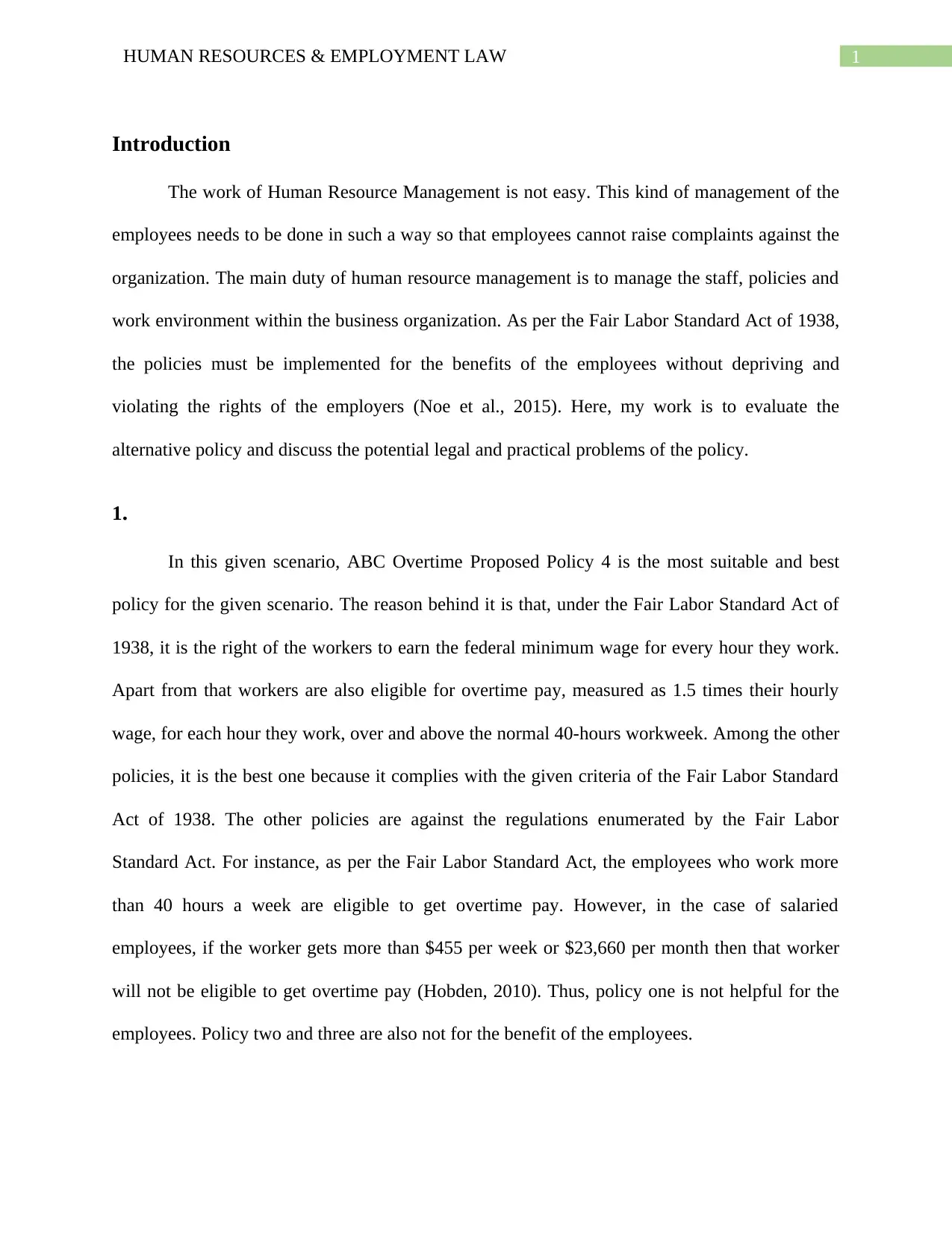
1HUMAN RESOURCES & EMPLOYMENT LAW
Introduction
The work of Human Resource Management is not easy. This kind of management of the
employees needs to be done in such a way so that employees cannot raise complaints against the
organization. The main duty of human resource management is to manage the staff, policies and
work environment within the business organization. As per the Fair Labor Standard Act of 1938,
the policies must be implemented for the benefits of the employees without depriving and
violating the rights of the employers (Noe et al., 2015). Here, my work is to evaluate the
alternative policy and discuss the potential legal and practical problems of the policy.
1.
In this given scenario, ABC Overtime Proposed Policy 4 is the most suitable and best
policy for the given scenario. The reason behind it is that, under the Fair Labor Standard Act of
1938, it is the right of the workers to earn the federal minimum wage for every hour they work.
Apart from that workers are also eligible for overtime pay, measured as 1.5 times their hourly
wage, for each hour they work, over and above the normal 40-hours workweek. Among the other
policies, it is the best one because it complies with the given criteria of the Fair Labor Standard
Act of 1938. The other policies are against the regulations enumerated by the Fair Labor
Standard Act. For instance, as per the Fair Labor Standard Act, the employees who work more
than 40 hours a week are eligible to get overtime pay. However, in the case of salaried
employees, if the worker gets more than $455 per week or $23,660 per month then that worker
will not be eligible to get overtime pay (Hobden, 2010). Thus, policy one is not helpful for the
employees. Policy two and three are also not for the benefit of the employees.
Introduction
The work of Human Resource Management is not easy. This kind of management of the
employees needs to be done in such a way so that employees cannot raise complaints against the
organization. The main duty of human resource management is to manage the staff, policies and
work environment within the business organization. As per the Fair Labor Standard Act of 1938,
the policies must be implemented for the benefits of the employees without depriving and
violating the rights of the employers (Noe et al., 2015). Here, my work is to evaluate the
alternative policy and discuss the potential legal and practical problems of the policy.
1.
In this given scenario, ABC Overtime Proposed Policy 4 is the most suitable and best
policy for the given scenario. The reason behind it is that, under the Fair Labor Standard Act of
1938, it is the right of the workers to earn the federal minimum wage for every hour they work.
Apart from that workers are also eligible for overtime pay, measured as 1.5 times their hourly
wage, for each hour they work, over and above the normal 40-hours workweek. Among the other
policies, it is the best one because it complies with the given criteria of the Fair Labor Standard
Act of 1938. The other policies are against the regulations enumerated by the Fair Labor
Standard Act. For instance, as per the Fair Labor Standard Act, the employees who work more
than 40 hours a week are eligible to get overtime pay. However, in the case of salaried
employees, if the worker gets more than $455 per week or $23,660 per month then that worker
will not be eligible to get overtime pay (Hobden, 2010). Thus, policy one is not helpful for the
employees. Policy two and three are also not for the benefit of the employees.
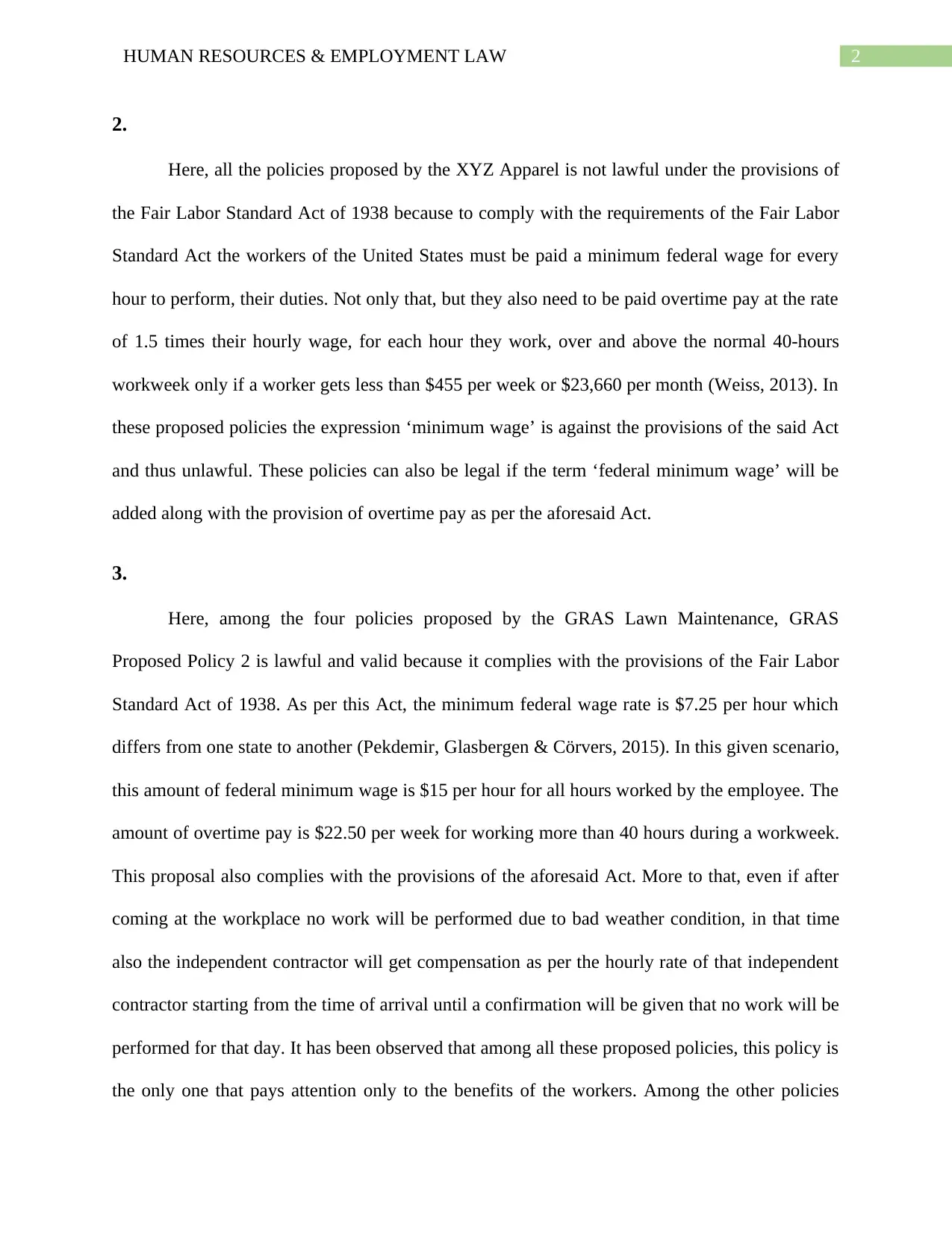
2HUMAN RESOURCES & EMPLOYMENT LAW
2.
Here, all the policies proposed by the XYZ Apparel is not lawful under the provisions of
the Fair Labor Standard Act of 1938 because to comply with the requirements of the Fair Labor
Standard Act the workers of the United States must be paid a minimum federal wage for every
hour to perform, their duties. Not only that, but they also need to be paid overtime pay at the rate
of 1.5 times their hourly wage, for each hour they work, over and above the normal 40-hours
workweek only if a worker gets less than $455 per week or $23,660 per month (Weiss, 2013). In
these proposed policies the expression ‘minimum wage’ is against the provisions of the said Act
and thus unlawful. These policies can also be legal if the term ‘federal minimum wage’ will be
added along with the provision of overtime pay as per the aforesaid Act.
3.
Here, among the four policies proposed by the GRAS Lawn Maintenance, GRAS
Proposed Policy 2 is lawful and valid because it complies with the provisions of the Fair Labor
Standard Act of 1938. As per this Act, the minimum federal wage rate is $7.25 per hour which
differs from one state to another (Pekdemir, Glasbergen & Cörvers, 2015). In this given scenario,
this amount of federal minimum wage is $15 per hour for all hours worked by the employee. The
amount of overtime pay is $22.50 per week for working more than 40 hours during a workweek.
This proposal also complies with the provisions of the aforesaid Act. More to that, even if after
coming at the workplace no work will be performed due to bad weather condition, in that time
also the independent contractor will get compensation as per the hourly rate of that independent
contractor starting from the time of arrival until a confirmation will be given that no work will be
performed for that day. It has been observed that among all these proposed policies, this policy is
the only one that pays attention only to the benefits of the workers. Among the other policies
2.
Here, all the policies proposed by the XYZ Apparel is not lawful under the provisions of
the Fair Labor Standard Act of 1938 because to comply with the requirements of the Fair Labor
Standard Act the workers of the United States must be paid a minimum federal wage for every
hour to perform, their duties. Not only that, but they also need to be paid overtime pay at the rate
of 1.5 times their hourly wage, for each hour they work, over and above the normal 40-hours
workweek only if a worker gets less than $455 per week or $23,660 per month (Weiss, 2013). In
these proposed policies the expression ‘minimum wage’ is against the provisions of the said Act
and thus unlawful. These policies can also be legal if the term ‘federal minimum wage’ will be
added along with the provision of overtime pay as per the aforesaid Act.
3.
Here, among the four policies proposed by the GRAS Lawn Maintenance, GRAS
Proposed Policy 2 is lawful and valid because it complies with the provisions of the Fair Labor
Standard Act of 1938. As per this Act, the minimum federal wage rate is $7.25 per hour which
differs from one state to another (Pekdemir, Glasbergen & Cörvers, 2015). In this given scenario,
this amount of federal minimum wage is $15 per hour for all hours worked by the employee. The
amount of overtime pay is $22.50 per week for working more than 40 hours during a workweek.
This proposal also complies with the provisions of the aforesaid Act. More to that, even if after
coming at the workplace no work will be performed due to bad weather condition, in that time
also the independent contractor will get compensation as per the hourly rate of that independent
contractor starting from the time of arrival until a confirmation will be given that no work will be
performed for that day. It has been observed that among all these proposed policies, this policy is
the only one that pays attention only to the benefits of the workers. Among the other policies
⊘ This is a preview!⊘
Do you want full access?
Subscribe today to unlock all pages.

Trusted by 1+ million students worldwide
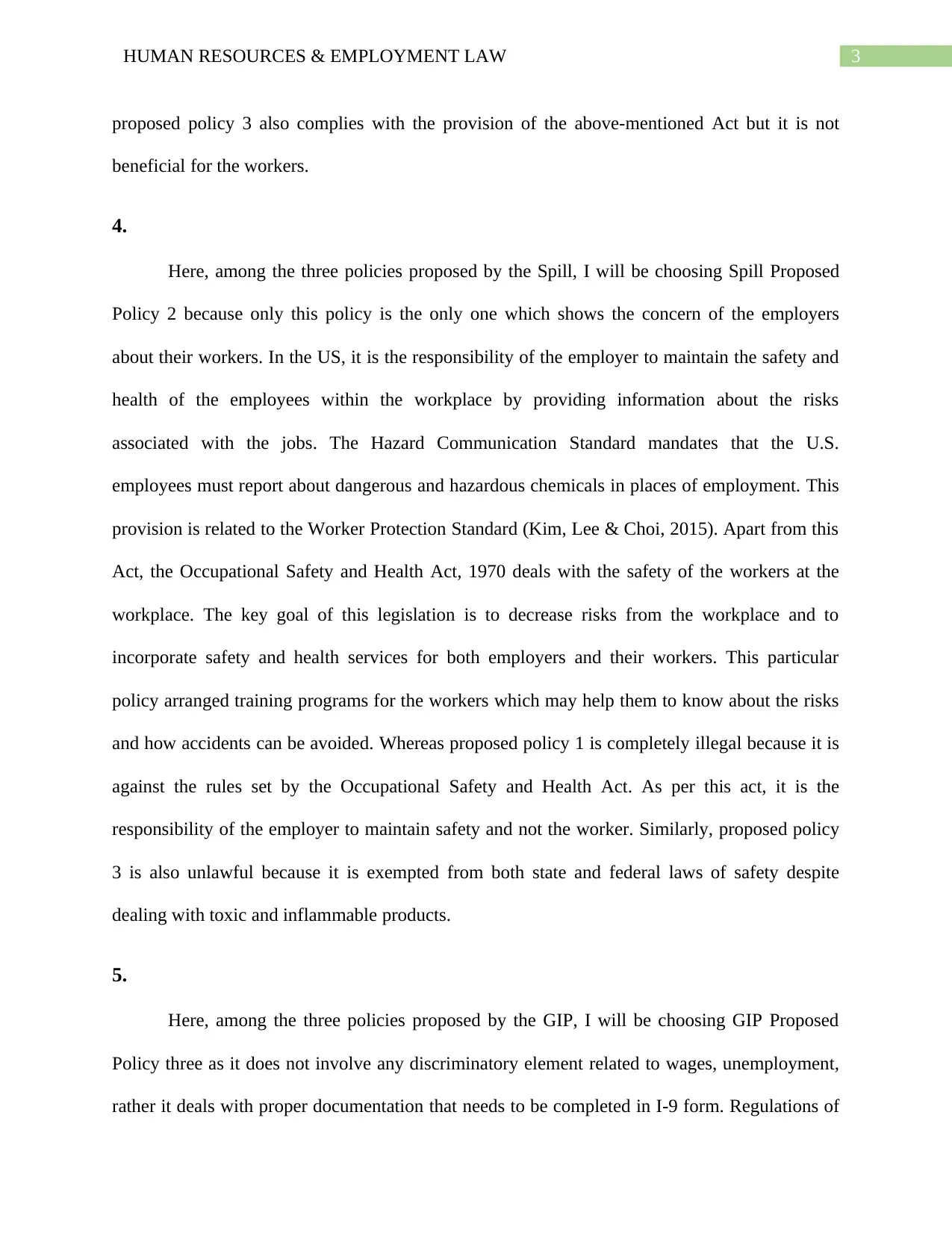
3HUMAN RESOURCES & EMPLOYMENT LAW
proposed policy 3 also complies with the provision of the above-mentioned Act but it is not
beneficial for the workers.
4.
Here, among the three policies proposed by the Spill, I will be choosing Spill Proposed
Policy 2 because only this policy is the only one which shows the concern of the employers
about their workers. In the US, it is the responsibility of the employer to maintain the safety and
health of the employees within the workplace by providing information about the risks
associated with the jobs. The Hazard Communication Standard mandates that the U.S.
employees must report about dangerous and hazardous chemicals in places of employment. This
provision is related to the Worker Protection Standard (Kim, Lee & Choi, 2015). Apart from this
Act, the Occupational Safety and Health Act, 1970 deals with the safety of the workers at the
workplace. The key goal of this legislation is to decrease risks from the workplace and to
incorporate safety and health services for both employers and their workers. This particular
policy arranged training programs for the workers which may help them to know about the risks
and how accidents can be avoided. Whereas proposed policy 1 is completely illegal because it is
against the rules set by the Occupational Safety and Health Act. As per this act, it is the
responsibility of the employer to maintain safety and not the worker. Similarly, proposed policy
3 is also unlawful because it is exempted from both state and federal laws of safety despite
dealing with toxic and inflammable products.
5.
Here, among the three policies proposed by the GIP, I will be choosing GIP Proposed
Policy three as it does not involve any discriminatory element related to wages, unemployment,
rather it deals with proper documentation that needs to be completed in I-9 form. Regulations of
proposed policy 3 also complies with the provision of the above-mentioned Act but it is not
beneficial for the workers.
4.
Here, among the three policies proposed by the Spill, I will be choosing Spill Proposed
Policy 2 because only this policy is the only one which shows the concern of the employers
about their workers. In the US, it is the responsibility of the employer to maintain the safety and
health of the employees within the workplace by providing information about the risks
associated with the jobs. The Hazard Communication Standard mandates that the U.S.
employees must report about dangerous and hazardous chemicals in places of employment. This
provision is related to the Worker Protection Standard (Kim, Lee & Choi, 2015). Apart from this
Act, the Occupational Safety and Health Act, 1970 deals with the safety of the workers at the
workplace. The key goal of this legislation is to decrease risks from the workplace and to
incorporate safety and health services for both employers and their workers. This particular
policy arranged training programs for the workers which may help them to know about the risks
and how accidents can be avoided. Whereas proposed policy 1 is completely illegal because it is
against the rules set by the Occupational Safety and Health Act. As per this act, it is the
responsibility of the employer to maintain safety and not the worker. Similarly, proposed policy
3 is also unlawful because it is exempted from both state and federal laws of safety despite
dealing with toxic and inflammable products.
5.
Here, among the three policies proposed by the GIP, I will be choosing GIP Proposed
Policy three as it does not involve any discriminatory element related to wages, unemployment,
rather it deals with proper documentation that needs to be completed in I-9 form. Regulations of
Paraphrase This Document
Need a fresh take? Get an instant paraphrase of this document with our AI Paraphraser
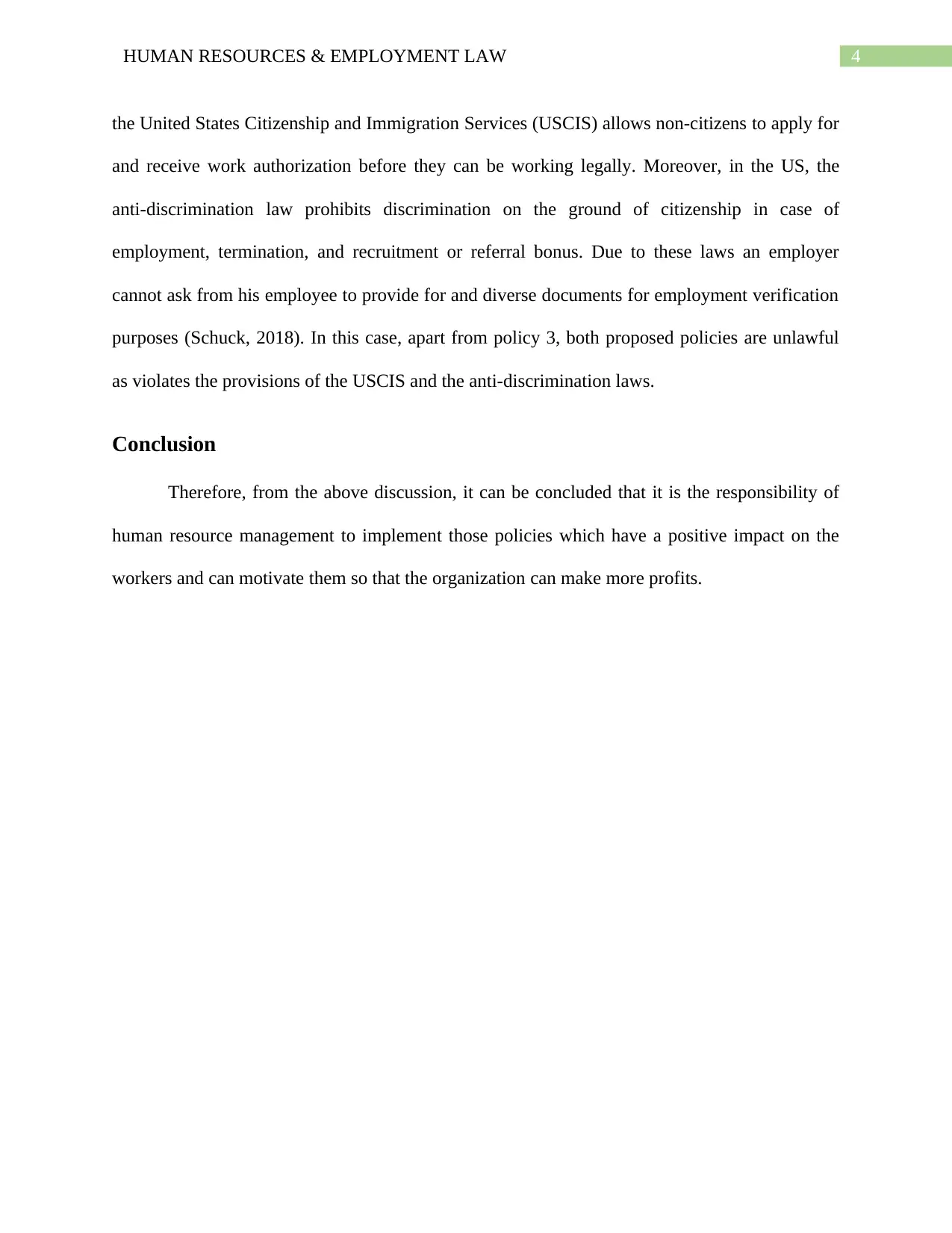
4HUMAN RESOURCES & EMPLOYMENT LAW
the United States Citizenship and Immigration Services (USCIS) allows non-citizens to apply for
and receive work authorization before they can be working legally. Moreover, in the US, the
anti-discrimination law prohibits discrimination on the ground of citizenship in case of
employment, termination, and recruitment or referral bonus. Due to these laws an employer
cannot ask from his employee to provide for and diverse documents for employment verification
purposes (Schuck, 2018). In this case, apart from policy 3, both proposed policies are unlawful
as violates the provisions of the USCIS and the anti-discrimination laws.
Conclusion
Therefore, from the above discussion, it can be concluded that it is the responsibility of
human resource management to implement those policies which have a positive impact on the
workers and can motivate them so that the organization can make more profits.
the United States Citizenship and Immigration Services (USCIS) allows non-citizens to apply for
and receive work authorization before they can be working legally. Moreover, in the US, the
anti-discrimination law prohibits discrimination on the ground of citizenship in case of
employment, termination, and recruitment or referral bonus. Due to these laws an employer
cannot ask from his employee to provide for and diverse documents for employment verification
purposes (Schuck, 2018). In this case, apart from policy 3, both proposed policies are unlawful
as violates the provisions of the USCIS and the anti-discrimination laws.
Conclusion
Therefore, from the above discussion, it can be concluded that it is the responsibility of
human resource management to implement those policies which have a positive impact on the
workers and can motivate them so that the organization can make more profits.
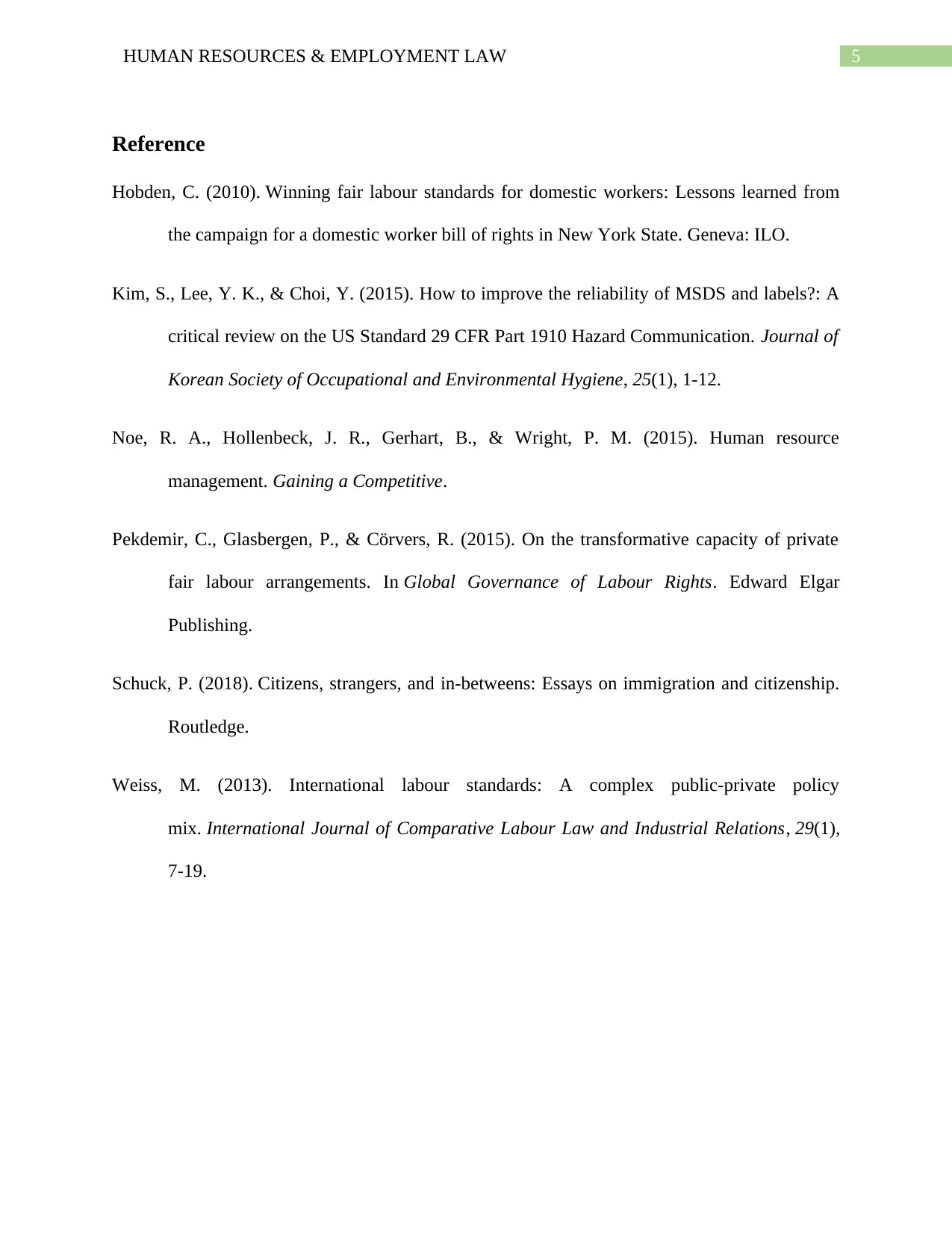
5HUMAN RESOURCES & EMPLOYMENT LAW
Reference
Hobden, C. (2010). Winning fair labour standards for domestic workers: Lessons learned from
the campaign for a domestic worker bill of rights in New York State. Geneva: ILO.
Kim, S., Lee, Y. K., & Choi, Y. (2015). How to improve the reliability of MSDS and labels?: A
critical review on the US Standard 29 CFR Part 1910 Hazard Communication. Journal of
Korean Society of Occupational and Environmental Hygiene, 25(1), 1-12.
Noe, R. A., Hollenbeck, J. R., Gerhart, B., & Wright, P. M. (2015). Human resource
management. Gaining a Competitive.
Pekdemir, C., Glasbergen, P., & Cörvers, R. (2015). On the transformative capacity of private
fair labour arrangements. In Global Governance of Labour Rights. Edward Elgar
Publishing.
Schuck, P. (2018). Citizens, strangers, and in-betweens: Essays on immigration and citizenship.
Routledge.
Weiss, M. (2013). International labour standards: A complex public-private policy
mix. International Journal of Comparative Labour Law and Industrial Relations, 29(1),
7-19.
Reference
Hobden, C. (2010). Winning fair labour standards for domestic workers: Lessons learned from
the campaign for a domestic worker bill of rights in New York State. Geneva: ILO.
Kim, S., Lee, Y. K., & Choi, Y. (2015). How to improve the reliability of MSDS and labels?: A
critical review on the US Standard 29 CFR Part 1910 Hazard Communication. Journal of
Korean Society of Occupational and Environmental Hygiene, 25(1), 1-12.
Noe, R. A., Hollenbeck, J. R., Gerhart, B., & Wright, P. M. (2015). Human resource
management. Gaining a Competitive.
Pekdemir, C., Glasbergen, P., & Cörvers, R. (2015). On the transformative capacity of private
fair labour arrangements. In Global Governance of Labour Rights. Edward Elgar
Publishing.
Schuck, P. (2018). Citizens, strangers, and in-betweens: Essays on immigration and citizenship.
Routledge.
Weiss, M. (2013). International labour standards: A complex public-private policy
mix. International Journal of Comparative Labour Law and Industrial Relations, 29(1),
7-19.
⊘ This is a preview!⊘
Do you want full access?
Subscribe today to unlock all pages.

Trusted by 1+ million students worldwide
1 out of 6
Related Documents
Your All-in-One AI-Powered Toolkit for Academic Success.
+13062052269
info@desklib.com
Available 24*7 on WhatsApp / Email
![[object Object]](/_next/static/media/star-bottom.7253800d.svg)
Unlock your academic potential
Copyright © 2020–2025 A2Z Services. All Rights Reserved. Developed and managed by ZUCOL.





